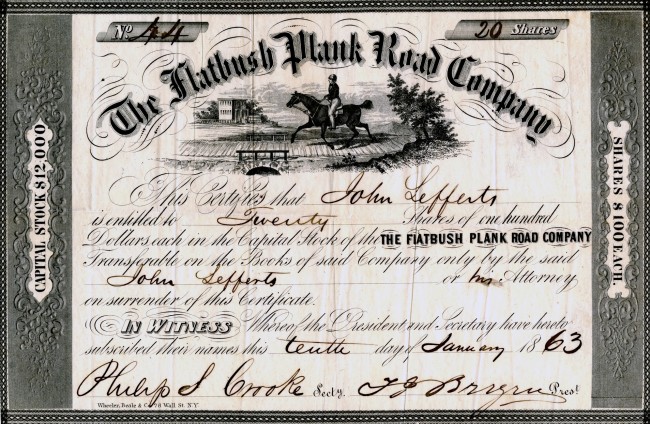“And bear in mind that millionaires
Their present fortunes planned
By little sums invested well
In choice Kings County Land”– Broadside Advertisement for Land Owned by John Lefferts, 1887
Despite their reverence for early Flatbush’s rural heritage, members of the Lefferts family were some of the town’s most zealous developers. As investors in roads, railroads, and real estate, they helped transform Flatbush into the busy, urban, and diverse neighborhood it remains today.

Stock certificate for The Flatbush Plank Road Company guaranteeing twenty shares to John Lefferts, 1863
Throughout the nineteenth century, family members invested in companies that would improve access to and from Flatbush town. In 1810, Lefferts Lefferts (1774-1847) of Bedford purchased stock in the Brooklyn, Jamaica, and Flatbush Turnpike Company, which connected Flatbush to the of Brooklyn, Bushwick, and others in Queens County. To improve the rough and muddy roads that crossed Kings County, John Lefferts (1826-1893) helped found the in 1855. By the 1880s, John’s son James (1855-1915) invested family money in the Brooklyn, Flatbush, and Coney Island Railway Company, established in 1878. In addition to bringing unprecedented numbers of New Yorkers to the resorts of Coney Island, the railroad also improved access between Flatbush, Brooklyn, and New York City.
New transportation options transformed areas of Kings County into viable residential neighborhoods for people who worked in the cities of New York and Brooklyn. By the end of the nineteenth century, Lefferts landowners in Flatbush, , and other areas recognized that their farms had greater real estate value than agricultural value. In 1887, John Lefferts (1826-1893) broke up and auctioned 516 parcels of land of the family’s Flatbush homestead. “The absurdity of devoting lands so desirable, central, and valuable to raising corn and potatoes,” the auctioneer of Lefferts’s land announced, “has finally induced the owner to part with [the] lots.”
John’s son James oversaw further development after his father’s death in 1893. Though the family sought to profit from the area’s real estate boom, they also hoped to shape Flatbush’s development on their own terms. James laid down a restrictive covenant limiting commercial or industrial development and requiring all dwellings built on former Lefferts land to be single family residential homes.
Learn More
How did real estate developers like John Lefferts market and sell their land?When he auctioned off over 500 residential plots from his family land in 1887, John Lefferts described Flatbush as an idyllic village that stood in stark contrast to the supposedly crowded, unhealthy tenements of New York City. To market the neighborhood, Lefferts’s real estate agents explicitly referenced the neighborhood’s Dutch heritage. “Unrivaled in health, beauty, and social attractions,” the 1887 real estate map of the Lefferts land boasted, “embalmed in the loving memories of her children, by the accumulated reminiscences of two hundred years, every spot is hallowed and every acre has a history of the sturdy men and thrifty women, who voluntarily left their native land to clear the forest and found homes amid savages.” Because of its rich history, the agents claimed, Flatbush compared favorably with “the garish ostentation of newer locations.” The evocative promotion of Lefferts’s land plots helped establish marketing techniques still used by the real estate industry today.


